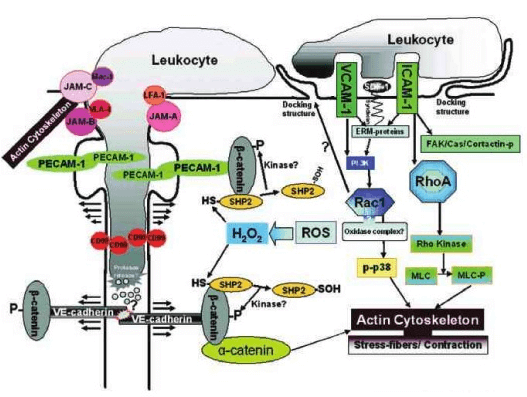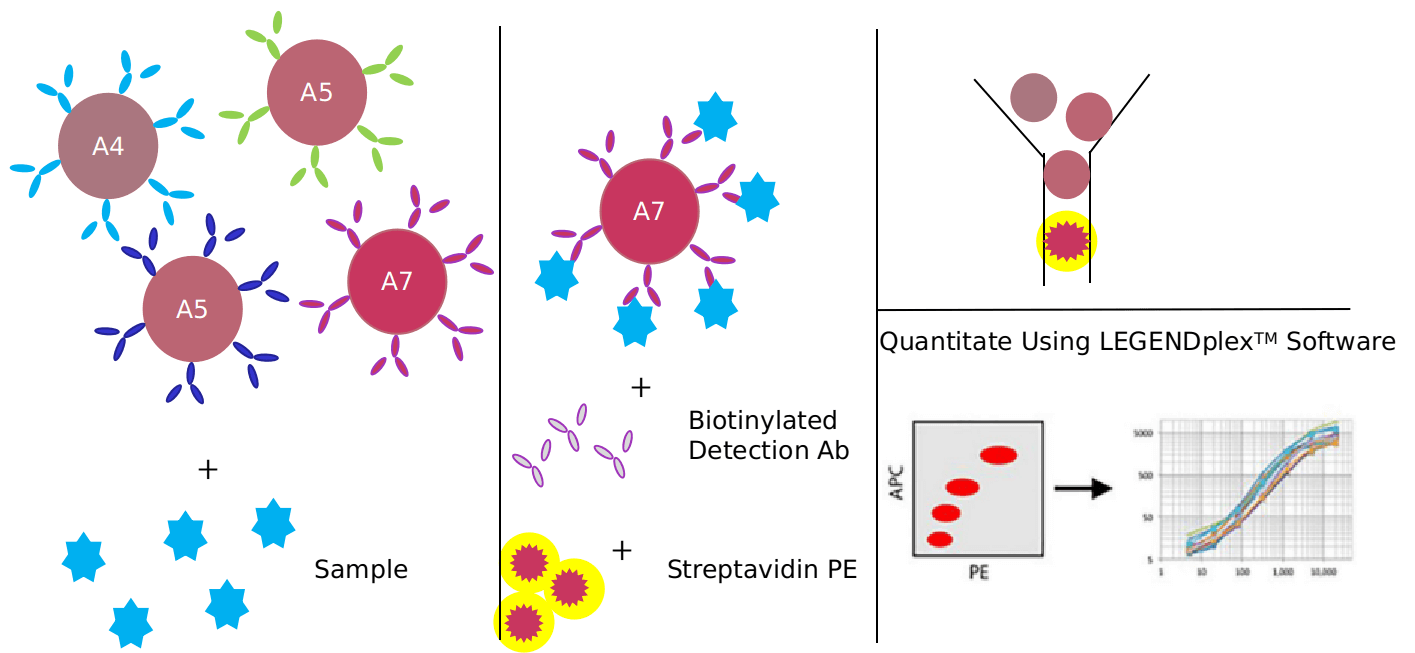Introduction to leukocyte transendothelial migration signaling pathway
Based on Luminex technology platform, Creative Proteomics provides analysis services for key targets of leukocyte transendothelial migration signaling pathway.
The migratory properties of white blood cells are indispens able to drive immune responses throughout the body. To ensure migration to the proper locations, the trafficking ot leukocytes is tightly regulated. The migration and extravasation of leukocytes across the endothelium that lines the vessel wall occurs in several distinct steps, referred to as the multi-ster paradigm, originally introduced by Butcher' and extended by Springer2 The first step comprises the rolling of the leukocytes over the endothelial cells. mediated by transient weak interac tions between adhesion molecules. Subsequently, loosely at- tached leukocytes are in such close proximity of the endotheliun that they can be activated by chemotactic cytokines, presented on the apical surface of the endothelium. As a consequence,the activated leukocytes will spread and firmly adhere to the endothelium and finally migrate through the intercellular clefts between the endothelial cells to the underlying tissue.

Leukocyte migaration from the blood into tissues is vital for immune surveillance and inflammation. During this diapedesis of leukocytes, the leukocytes bind to endothelial cell adhesion molecules (CAM) and then migrate across the vascular endothelium. A leukocyte adherent to CAMs on the endothelial cells moves forward by leading-edge protrusion and retraction of its tail. In this process, alphaL /beta2 integrin activates through Vav1, RhoA, which subsequently activates the kinase p160ROCK. ROCK activation leads to MLC phosphorylation, resulting in retraction of the actin cytoskeleton. Moreover, Leukocytes activate endothelial cell signals that stimulate endothelial cell retraction during localized dissociation of the endothelial cell junctions. ICAM-1-mediated signals activate an endothelial cell calcium flux and PKC, which are required for ICAM-1 dependent leukocyte migration. VCAM-1 is involved in the opening of the "endothelial passage" through which leukocytes can extravasate. In this regard, VCAM-1 ligation induces NADPH oxidase activation and the production of reactive oxygen species (ROS) in a Rac-mediated manner, with subsequent activation of matrix metallopoteinases and loss of VE-cadherin-mediated adhesion.
The extravasation of leukocytes is essential for many (patho) physiological processes, including migration of T-lymphocytes for immune surveillance, recruitment of activated lymphocytes and granulocytes during acute and chronic inflammatory re sponses, and homing and mobilization of hematopoetic progen itor cells.
Our detectable targets:
| ACTB | ACTN1 | AFDN | ARHGAP35 | ARHGAP5 | BCAR1 |
| CD99 | CDC42 | CDH5 | CLDN20 | CTNNA1 | CTNNB1 |
| CTNND1 | CXCL12 | CXCR4 | CYBA | CYBB | ESAM |
| EZR | F11R | Mda-5 | NFκB | RIG-1 | TRAF3 |
| GAS | IRF9 | MEKK1 | p38 | RIP1 | TRAF5 |
| Histone-H3 | IRF5 | MEK3 | p38MAPK | SH2 | TRAF6 |
Technology platform
We provide Luminex technology for leukocyte transendothelial migration signaling pathway analysis.
Luminex technology is a multifunctional liquid phase analysis platform developed on the basis of colored microspheres, laser technology, applied fluidics and high-speed digital signal processing technology. The core is to encode polypropylene microspheres or magnetic microspheres with fluorescent dyes. By adjusting the different ratios of the two fluorescent dyes, up to 100 microspheres with different fluorescence spectra can be obtained. Each kind of microspheres is covalently cross-linked. Capture antibodies against specific antigens.
Leukocyte transendothelial migration is widely used in the migration of T lymphocytes for immune surveillance, the recruitment of activated lymphocytes and granulocytes during acute and chronic inflammation, and the homing and mobilization of hematopoietic progenitor cells.
In addition to Luminex Multiplex Assay, Enzyme-linked immunosorbent assay (ELISA), Flow cytometry (FACS analysis) technology can also be provided to meet other customer needs.
Advantages of leukocyte transendothelial migration signaling pathway detection:
- Versatility: VEGF signaling pathway technology can be applied to a variety of biological tests, including immune analysis, genotyping, gene expression, enzyme analysis, etc. It can detect both protein and nucleic acid. In addition to clinical use, it can also be used in scientific research, CDC, blood stations, agricultural, biological and pharmaceutical professional laboratories.
- Good repeatability: similar homogeneous reaction mode, each indicator has 1000-5000 reaction units, and the median value of 100 analysis is taken. High accuracy: the detection range is 35-6 orders of magnitude, which is very strong with ELISA and mass spectrometry.

Application of our service:
- To study the regulation mechanism of leukocyte transendothelial migration signal pathway in disease
- To study the effect of each virus on leukocyte transendothelial migration signaling pathway
- To study the effects of drugs or therapies on leukocyte transendothelial migration signaling pathways
Creative Proteomics has developed a signal pathway target detection platform. We are not limited to providing leukocyte transendothelial migration signal path detection services, but can also provide other signal path detection services. If you want to detect other targets, please contact us and we will customize the service for you. Look forward to working with you.
References:
- ButcnerLeukocyie-cndothelial cell recosmton three more steps to specificity and diversity. Cell, 2018, 67:1033-1036.
- SpringerTA.Traffic signals for lymphocyte recirculation and leukocyte emigration the multistep aradigm. Cell, 2019, 76: 301-314.



